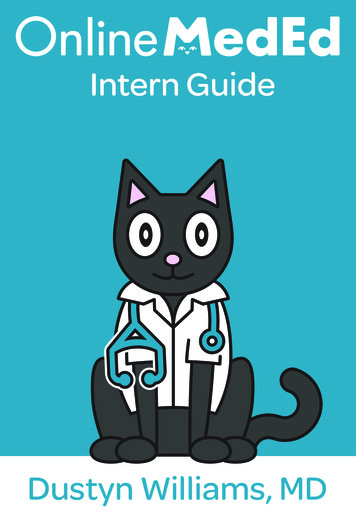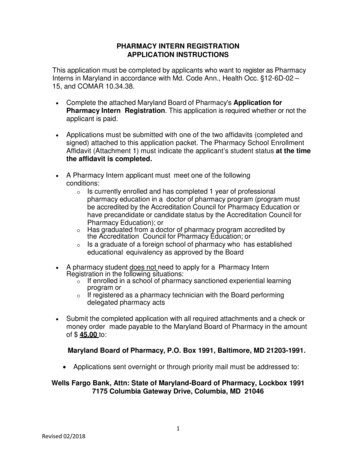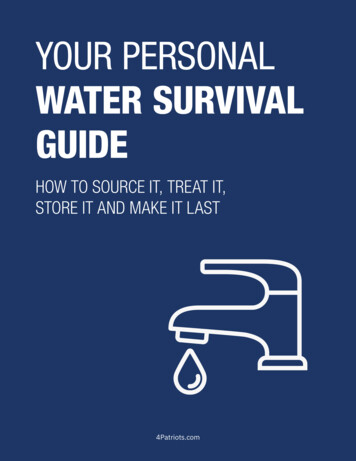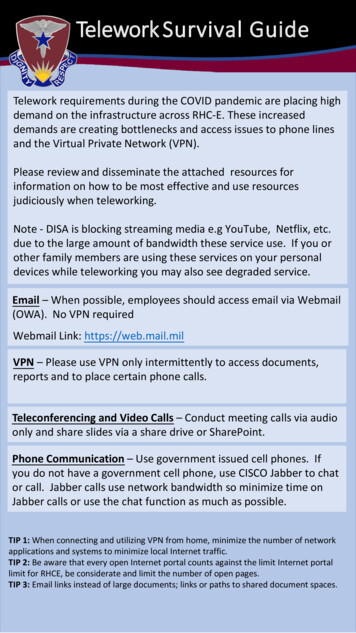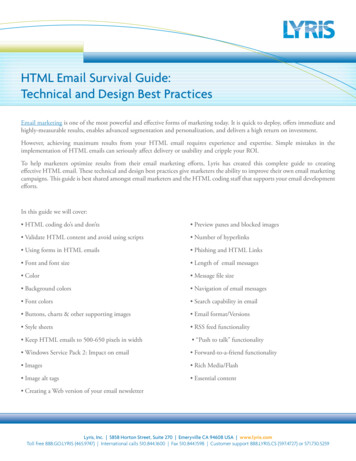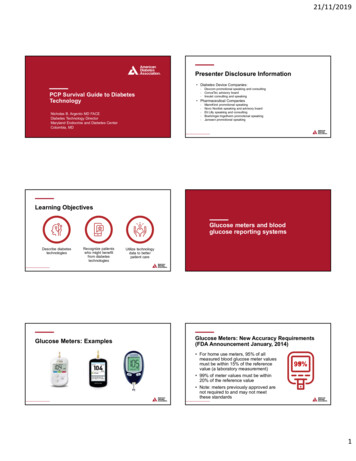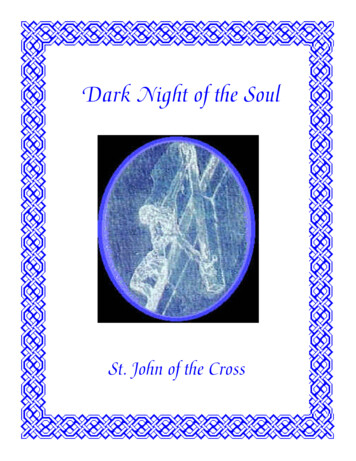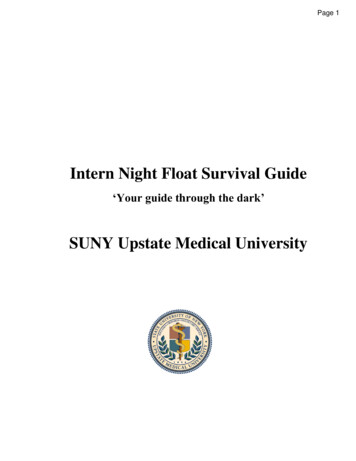
Transcription
Page 1Intern Night Float Survival Guide‘Your guide through the dark’SUNY Upstate Medical University
List of Topics:Page NumberLeaving Against Medical Advice (AMA)4Constipation4Pain Control5Acute Anemia6Low Urine Output7Hypoglycemia8Chest Pain9Arrhythmias/ACLS10Atrial Fibrillation11Hypertension12Acute GI bleed13Shortness of Breath14Oxygen Delivery system15Electrolyte Replacement16Hyponatremia17Hyperkalemia18Abdominal ation/Confusion20Fever21Sepsis22Phone Numbers23
Page 3INTRODUCTIONWelcome to world of ‘night float’. Night float is a unique rotation which gives you theautonomy of making many clinical decisions. Remember, ‘with great power there mustalso come - great responsibility! (Ref: Ben Parker, Spiderman), after all, you are ‘crosscovering’ for other physicians’ patients. This book has been assembled by senior / chiefresidents as well as faculty members to help you with important tips and tricks to guideyou through your night float rotation. It includes topics which the night float is mostcommonly contacted about by nursing staff. Each topic includes the information youneed to obtain from nursing staff /chart and possible differential diagnosis andmanagement based on etiology. Although this book has several helpful hints andreferences, please remember to use your clinical judgment in each individual case.Remember: you always have your senior with you!We look forward to working with you and we know it will be a great year! We also lookforward to hearing any suggestion / tips from you to make this manual better.Sincerely,SUNY Upstate Medical University.Department of Internal Medicine.RESIDENT AUTHORSFACULTY MENTORRushikesh Shah. M.B.,B.S.Viren Kaul. M.B.,B.S.Amit Dhamoon. MD, PhD.CONTRIBUTING AUTHORSOmair Chaudhary. MD.Harvir Singh Gambhir. M.B.,B.S., M.D.Arpan Patel. MD.Subhash Sitaula. M.B.,B.S.Sumendra Joshi. M.B.,B.S.Shalin Kothari. M.B.,B.S.Syed Wajihuddin. M.B.,B.S.Priyanka Pitroda. MD.Aditya Kalakonda. MD.Aakriti Pandita. M.B.,B.S.Pallavi Kopparthy. M.B.,B.S.
Page 4PATIENT LEAVING AGAINST MEDICAL ADVICE Discharge against medical advice (AMA) is asituation in which a patient chooses to leave thehospital before the treating team recommendsdischarge. Review patient’s chart and ensure that patient doesnot have a condition that impairs his / her capacity tomake decisions. e.g psychiatric problems, mentalretardation, encephalopathy, delirium. Suicidal patient, or patients admitted after attemptingto commit suicide are not allowed to leave unlessspecifically recommended by psychiatry. Review sign out for instructions from primary team. Talk to patient. Most common scenarios whenpatients decide to do this are: dissatisfaction with their care. dissatisfaction with staff taking care of them. feeling uninvolved. Feeling of not being updatedon clinical progress. inadequate pain control personal problems. Attempt to answer patient’s questions as directly aspossible. Attempt to alleviate concerns by providinginformation. Resolve any medical concerns such aspain control if deemed reasonable. If patient decides to leave anyway, explain to him /her all possible consequences of leaving prior tocompleting treatment. Provide them with theappropriate AMA form to sign. Let the senior NF/ nocturnist know. Completemedical reconciliation to the best of your ability.Provide scripts if needed. NEVER prescribecontrolled substance. Advise appropriate follow ups. Document your conversation with patient. You don’thave to do the discharge summary but mention inbrief why the patient chose to leave and that youexplained the potential risks which he / sheunderstood. Make sure to document that patient hadthe capacity to understand the decisions regardinghis medical care. Inform the team and concerned attending in themorning.CONSTIPATION Defined as decrease in frequency ( 3 BMs / week) orchange in consistency to hard / lumpy stool or difficultyin evacuation with feeling of incomplete evacuation. Prior to prescribing medications, ensure patient is notobstructed. Is the patient passing flatus ? Any vomiting? Abdominal pain ? If concerned, examine for signs ofsurgical abdomen. Review the chart to for medications which can causeconstipation: opioids, anticholinergics, 1st degreeantihistaminics. Evaluate patient’s bowel medications. (All patientswith opioids should be on bowel regimen) Once dynamic obstruction is ruled out, may ordermedications as follows:Stool softeners : Docusate 100 mg BID: Takes 24 - 72 hours foronset of action.Stimulants : Senna (2 to 4 tablets daily): Works in 6 -12 hours. Bisacodyl 10 to 30 mg tablet daily: Works in 6-10hours. 10 mg suppository works in 15-60 minutes.Osmotic agents: Magnesium sulfate 1 - 2 teaspoons in water: Actsin 0.5 – 3 hours (Avoid in renal insufficiency). Polyethylene glycol 8 to 34 gms daily: Acts in 1-4days. Lactulose (10-20 gms): Works in 2 - 4 hours.Enemas: If patient is on reasonably good bowelregimen with no BMs in 3 - 4 days with no signs ofobstruction, consider enemas. Can use bisacodyl, tapwater, lactulose enema. Avoid phosphate enemas inrenal dysfunction and elderly. Remember, reverse underlying pathologies causingthe constipation: pain, urinary retention, recentsurgery, opioid use, dehydration. In intractable cases, may consider manual fecaldisimpaction.
Page 5PAIN CONTROL#1. Information from nursing:#2. Information from chart/sign out: Acuity: New onset vs. exacerbation of known pain? PQRST ? Red flags: Fever, focal deficits, LOC, dizziness, chest pain,dyspnea, increased oxygen requirement. Wounds? Recent surgery? Incisional pain? Hemodynamic stability especially for chest pain, abdominalpain. #3. Triage: Does the patient need to be seen? andinitial assessment: Chest pain: Please refer to segment on chest pain. Headache: New onset, intractable, auras, focal deficits. Back pain: Neurological deficits, saddle anesthesia,incontinence. Post operative pain: Incisional healing, signs of infection. Fall: Evaluate for acute fractures. Does patient need neckstabilization? Abdominal pain: Surgical signs? No flatus / feces? Guarding /rigidity? H/O of sickle cell disease: Crisis? acute chest? bone crisis? ALWAYS ASSESS PAIN IN THE SETTING OFHEMODYNAMIC INSTABILITY.#5. Opioid administration:If patient can take PO and no risk of aspiration: Use lowest doseas one time order. Tramadol: Synthetic. Use 50 mg doses PRN. Hydrocodone/tylenol: 5/325 or 5/500 mg (may repeat Q4 - 6hours) Oxycodone:5 mg (may repeat Q4 - 6 hours) Morphine IR: 15 or 30 mg dose.If unable to take PO / aspiration risk: Fentanyl 25 to 50 mg IV (based on BMI). May repeat Q2 - 4hours (shorter acting drug) Morphine 2 or 4 mg IV (based on BMI). May repeat Q 2- 4hours if needed.Try to find out a cause of the reported pain. Is it known?Existing regimen ? Recommendations from primary team.Review home pain regimen.Review common reasons for contraindication to meds: NSAIDs: GI bleed, GERD, recent ACS, allergy, AKI. Tylenol: Acute / fulminant liver failure, toxicity. Narcotics: Allergy, intolerance, poor respiratory reserve,old age, renal dysfunction.#4. Management: Work up emergent causes of pain if being considered (asexplained in #3) Non opioid options: Tylenol: MDD: 4 gm, MDD with liver failure: 2 gm. Maybeused PRN (650 mg Q6H PRN). If not effective, considerstanding doses for 24 hours (inform team). Standing tylenolworks better than PRN. Can also be administered perrectal. NSAIDs: Work well for acute pain. Local agents: Lidocaine patch / gel / ointment, diclofenacgel. Opiods: Use sparingly. Work well for acute pain, especially postoperative pain. Order one time doses only. Inform team in AM. Already on opioids: If no C/I, give a one time dose afterenquiring about the last dose. Try to give same drug asbeing used. Do not order long acting doses. Opioid naive: Consider one time doses of lowest dose ofopioid (see #4)#5. Important considerations: Avoid ordering standing doses. Avoid long acting formulations. Always sign out pain control issues to primary service so they mayaddress it on rounds. Always assess sign out. Primary service may recommend not usinga certain medication for specific reasons. Handy tool to convert doasage (roughly) from one opioidmedication to another: m/
Page 6ACUTE ANEMIA (CALL FOR DROP IN HEMOGLOBIN / HEMATOCRIT)#1. Information from nursing: Symptoms ? Vitals: Hemodynamically stable? : Tachycardia,hypotension. Orthostatic symptoms and vitals? Any obvious source of bleeding – GI, urine, sputum,surgical site, wound.#3. Initial assessment: Whom to assess: Decrease in Hb 1 unit & Hct 3units or active bleeding warrants assessment. Vitals: Tachycardia, orthostasis, hypotension signifiesintravascular depletion especially in setting of anemia /dehydration. Orthostatics are a sensitive exam finding. If not able to do orthostatic vitals: See HR and BPresponse to leg raising. Identify source of bleeding: GI: hematemesis, melena, hematochezia. Do a perrectal exam if suspicious and send for FOBT.Assess abdomen for surgical signs. Post surgical/wound : check surgical site or wound. Hemothorax: Lung exam for decreased sounds. For concealed bleeding: significant drop w/hemodynamic compromise: Consider retroperitoneal /abdominal , pelvis or hip bleeding. If recent vascularprocedure / cath: Retroperitoneal bleeding high ondifferential. Consider abrupt in pregnant patients. If no source of bleeding: Hemodynamic stability with decrease in all cell lines:Dilution / error. Common in 1st 48 hours ofhospitalization. Nutritional: review/obtain iron panel, Vitamin B12,folate. Evaluate for hemolysis in appropriate settings: sepsis,autoimmune disease, liver disease, DIC.#5. Reversal of anticoagulation (please see section onreversal of anti coagulation for details): 2/2 Coumadin / liver disease: Vitamin K (PO preferred,may use IV. Avoid SQ). FFPs. K - centra. Platelets if thrombocytopenia. Use desmopressin if patient is uremic. Hold all anti platelets, especially if hemodynamicallyunstable.#2. Information from chart review / sign out: Is there a known source of bleeding under investigation? Trend the Hb / Hct to assess acuity of drop. Is there adrop in WBC / platelets: Dilution ? Is patient on anti platelet meds / anticoagulation ? Did patient have recent surgery or endovascularprocedure.#4. Interventions: Ensure adequate IV access: 2 wide bore IVs. Investigations / labs: Repeat CBC if suspecting dilution / error. Type and cross. INR / PTT Send anemia work up as mentioned in #3 ifwarranted. CT abdomen / pelvis if concerned for retroperitonealbleeding / intra abdominal bleeding. CXR to evaluate for hemothorax. Hemodynamically unstable: Start fluid resuscitation.Consider PRBC transfusion (see below). Call SNF.Discontinue anticoagulation, consider reversal (please seesection on reversal of anticoagulation). For mild drop in asymptomatic patient w/o hemodynamiccompromise: Observe. Send work up as in #3. Followthrough night for stability. Inform primary team. Keep transfusion threshold at Hb 7 and Hct 21 orfollow primary team’s instructions. For patients with activeACS, transfusion threshold is low (around 8 and 24). Cantransfuse 1-2 units at a time. Reversal of anticoagulation: See #4. For GI bleed: see the section on GI bleed For surgical site bleeding: D/C anticoagulation ifsignificant bleeding. Consult surgical services.#6. Special considerations: Jehovah’s witness: due to cultural beliefs you can’ttransfuse these patients. Discuss with the patient anddocument in chart informing possible risk. You canresuscitate with IVF. If hemodynamically significant bleed, discuss with SNF,consider MICU consult. If unable to obtain good IV access, consider CVC.
Page 7LOW URINE OUTPUT#2. Information from chart review / sign out:#1. Information from nursing: Acuity ? Duration ? Does patient have Foley catheter ? Is it draining ? If not: What is the post - void residual urine ? If 100 cc: evaluate etiology. If 200 cc: straight cath. If 400 cc: place a foley catheter and leave it in place. If patient has ascites, bladder scanning overestimates the bladdervolume. Associated symptoms: fever, signs of infection ? Oliguria ( 500 cc/day or 0.5 cc/kg/hr) / anuria (No urine output). Fluid status: I/Os, including cumulatives. Does patient have areason to be hypovolemic ? Med review: Diuretics, IV fluids, drugs with anti - cholinergicproperties (cause retention). Other factors: Pain / recent surgery / constipation (impair bladderemptying). Labs: BUN / Cr and Sr. Osm (does it suggest intravasculardepletion or overload ?)#4. Treatment:#3. Assessment: Volume status assessment: Intravascularly depleted or volumeoverloaded ? Intravascular depletion: Mucus membranes, skin, BP, HR,UOP, mental status. Remember orthostatic signs aresensitive for detecting depletion especially in cases ofbleeding. Overload: JVD, crackles, edema, S3. Patient already has Foley ? Ensure it is draining. Ask nursing staffto flush and confirm patency. Look for underlying causes: Intravascular depletion: Sepsis, poor PO intake, excessivediuresis etc. Overload: Fluids, ACS, arrhythmias, CHF. Overload state: Consider diuresis. Treat primary cause or concomitant issues (arrhythmias). Intravascularly depleted ? IV fluid boluses: 250 - 500 ml. If improvement noted, place onmaintenance fluids (for 1000 ml) and inform primary team. Treat primary cause: Sepsis, diarrhea, etc. Remove offending factors: Anti cholinergic meds, pain meds,constipation.NOTES
Page 8HYPOGLYCEMIA#2. Information from chart review / sign out:#1. Information from nursing: How low is the fingerstick ? First time or recurrent ? Is patient symptomatic? Diaphoresis, confusion, tremor, fatigue,loss of consciousness. When was last insulin dose administered, what type ? Last longactin
Arrhythmias/ACLS 10 Atrial Fibrillation 11 Hypertension 12 Acute GI bleed 13 Shortness of Breath 14 . Although this book has several helpful hints and references, please remember to use your clinical judgment in each individual case. Remember: you always have your senior with you! We look forward to working with you and we know it will be a great year! We also look forward to hearing any .
